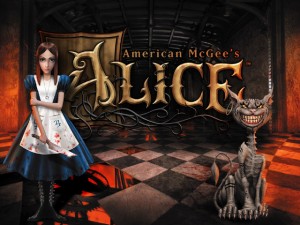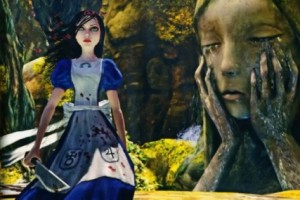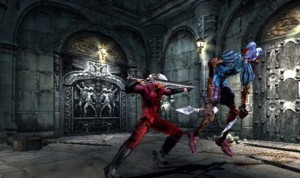It’s safe to assume that you have at least heard of Alice in Wonderland by Lewis Carroll, whether through the book itself, the Disney classic based on it, the Tim Burton “re-imagining”, any of the lesser known TV movies based on it, or even the porno (yes, there’s a porno – click for a review, which is NSFW, for obvious reasons). But in October 2000, a PC game that explored a darker Wonderland was released for the PC.
 Alice and the Cheshire Cat as they’re depicted in the game.
Alice and the Cheshire Cat as they’re depicted in the game.
American McGee’s Alice told the continuing story of Alice Liddell after her childhood adventures in Wonderland. She’d never learned to let go of her makebelieve world, and – after being committed to an insane asylum following the death of her parents in a house fire – returns to Wonderland in her teens to find it a broken place that she is in danger of losing herself in.
While the game’s controls felt about as responsive as if you were playing with oven gloves on, overall it was great fun, with an immersive storyline, stunning visuals and voice acting, and with music capable of making small children weep.
In a very belated follow-up to the success of the first game, the sequel Alice: Madness Returns was released on a number of platforms in June this year.
 Alice’s “Next Gen” appearance in Madness Returns.
Alice’s “Next Gen” appearance in Madness Returns.
The music for the original game was composed by sometimes N.I.N. live drummer and general ‘fingers in all pies’ session musician, Chris Vrenna, while the sequel’s music was mostly the work of Jason Tai.
Highlights in American McGee’s Alice for me include:
This song, Wonderland Woods, creates a mood of both childlike naivity and immense sadness, using a combination of tinkling xylophones and long, drawn-out notes on string instruments. I get a few different ‘feels’ from this track, but it’s usually something sad that’s happening. I could picture pallbearers struggling to carry a coffin through the rain, or maybe a wounded solider dragging himself through the mud because he’s lost his legs. It’s the kind of scene you could see with Atreyu and Artax in the Swamp of Sadness.
I love the Funhouse track; the high-pitched, jerky rhythm of whatever stringed instrument that is mixed in with incoherent babbling and howling winds.
If I ever wrote a story about giant marionettes that came to life and started to come to life and slaughter the people of a sleepy country village, this is the kind of music I’d envision them hobbling around to.
Listening to I’m Not Edible, I picture a victim, maybe strapped to a gurney, being wheeled down a hospital corridor. I see people hovering over them, talking, maybe there’s drugs in the character’s system, showing through the disortion of the old rhyme of ‘My Grandfather’s Clock’.
Moving onto the sequel, Madness Returns:
I can see a dream-like state working well to this, I get the sensation of a hazy environment, walking through mists, maybe the vague outline of a familiar person in the distance. In fact, I think this song’s title, Castles in the Sky, suits it very well.
I picture in my head some kind of deformed masquerade ball when I hear this, maybe like the scene in Labyrinth, without the weird Jareth/Sarah romance bit, or maybe this scene from the BBC version of Pride and Prejudice (plus the timing works with both scenes, if you put the videos on silent…and yes I have tried this, because I’m a goon).
When I listen to this, I firstly picture someone running through darkened corridors. I also see the kind of scene where someone frantically searches for clues, something they’ve happened upon once upon a time and didn’t realise the significance of until that just now, and when the piano kicks in, that’s the moment where the focus shifts from their face to the tattered old letter in their hand that reveals they are in fact related to the crazy old man whose house they’re currently trapped in.
NOTE: The videos used for the Madness Returns examples are actually extended versions of the soundtrack releases, since it’s a crying shame game soundtrack music tends to suffer from “Shorttrackitis”, and one very nice YouTuber has taken the liberty of sewing some of the loops together in a lovely fashion for us listener-types.
Music to Write ‘Crazy’ Scenes By…
It should come as no surprise that both soundtracks suit writing about anything you want to have a detached or macabre feel.
In the case of the original, some of the tracks are opened by brief, in-game dialogue (here’s one example, and here’s another). This may enhance or damage your inspiration, depending on whether you can draw anything from the words.
For me, personally, I think the original soundtrack does a better job of creating tracks that you get a proper feel of someone who might be losing their mind, whereas the sequel’s album creates a desolate and grim atmosphere, but not necessarily something quite so obscure.
I find both work well for me, but in different circumstances.
More Information / Further Reading
Information on the game can be found on Wikipedia.
You can buy both game albums from iTunes:
American McGee’s Alice on iTunes
Alice: Madness Returns on iTunes
Check out the full list of my ‘Music to Write Novels By’ series here, including a spiffy FAQ section, which will likely cover any questions you have.
